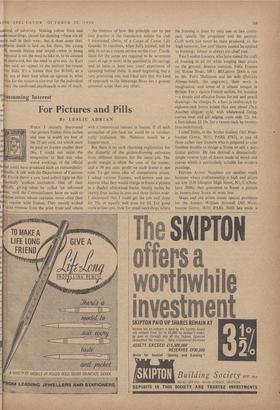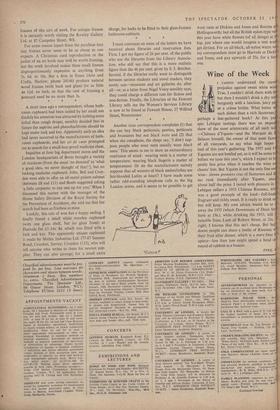onsuming Interest
For Pictures and Pills
By LESLIE ADRIAN WHEN I recently discovered that picture frames three inches and over in width are free of the 25 per cent. tax which must he paid on frames smaller than this, I could not resist the temptation to find out what weird workings of the official lid could have produced such an extraordingry rmula. A talk with the Department of Customs Excise threw a new (and,softer) light on this osedly 'soulless institution. One of their 6ials, giving what he called 'an informed r,, said the Commissioners have no wish to hake artists, whose. canvases, More often than I, require wide. frames. They merely wished raise revenue from the print trade and others with a commercial interest in frames. If all such anomalies of purchase tax could be so satisfac- torily explained, Mr. Nabarro would be a happier man.
But there is no such charming explanation for the disparity of the picture-framing estimates from different framers for the same job. The profit margin is often the crux of the matter, and a 50 per cent. profit on each frame is not rare. To get some idea of comparative prices, I asked various framers, well-known and un- known, what they would charge to frame a picture in a shaded whitewood frame, twenty inches by twenty-four inches in area and three inches wide. I discovered that I could get the job well done for 35s. or equally well done for £4. For good work aglow cost, look for small workshops where the framing is done by only one or two crafts- men, ideally the proprietor and his partner. Craft work can never be mass produced, so the 'high turnover, low cost' theory cannot be applied to framing: labour is always the chief, cost.
Two London framers, who have raised the craft of framing to an art while keeping their prices on the ground, deserve mention. Felix Frames (41 Sloane Street, SW1; BELgrave 5844) is run by Mr. Felix Mallinson and his wife (Patricia Allman-Smith, the engraver); their work is imaginative, and some of it almost unique in Britain. For a square French section, for instance —a simple and effective frame for ink and penCil drawings—he charges 5s. a foot (a twelve-inch by eighteen-inch frame would thus cost about 25s.). Another elegant style, with whitewood lining, canvas inset and gilt edging, costs only I2s. 6d. a foot (about £4 10s. for a twenty-inch by twenty- four-inch frame).
Lionel Irwin, at the Archer Gallery (303 West- bourne Grove, W11; PARk 8761), is one of those rather rare framers who is prepared to take limitless trouble to design a frame to suit a par- ticular picture. He has devised a dramatically simple reverse type of frame made of wood and canvas which is particularly suitable for modern paintings.
Peytons Artists' Suppliers are another small business where craftsmanship is high and prices are low (110 Islington High Street, NI; CANon- bury 5038); they guarantee to frame a picture in twenty-four hours or even less.
Maps and old prints create special problems for the framer. William Attewell (305 West- bourne Grove, W11; PARk 7010) has made a feature of this sort of work. For antique frames it is certainly worth visiting the Rowley Gallery Ltd. at 87 Campden Street, W8.
For some reason (apart from the purchase tax) tiny frames never seem to be as cheap as one expects. A Christmas card reproduction or the jacket of an art book may well be worth framing, but the work involved makes these small frames disproportionately expensive at anything from 7s. 6d. to 10s. But a firm in Essex (Arts and Crafts, Harlow; phone 24146) produce natural wood frames (with back and glass) for as little as lid. an inch, so that the cost of framing a postcard need be no more than 3s.
A short time ago a correspondent, whose bath- room cupboard had been raided by her small son (luckily his attention was attracted by nothing more lethal than cough drops), sensibly decided that in future the aspirins and phenobarbitone should be kept under lock and key. Apparently such an idea had never occurred to the manufacturers of bath- room cupboards, and her cri de cceur prompted me to search for a small-boy-proof medicine chest.
Inquiries at four big department stores and the London headquarters of Boots brought a variety of reactions (from the usual 'no demand' to 'what a good idea, we never thought of that!'), but no locking medicine cupboard. John, Bell and Croy- den were able to offer an all-metal poison cabinet (between £8 and £11) and Boots suggested asking 'a little carpenter to run one up for you.' When I discussed this matter with the manager of the Home Safety Division of the Royal Society for the Prevention of Accidents, she told me that her search had been as fruitless as mine.
Luckily, this tale of woe has a happy ending. I finally found a small white wooden cupboard (with one glass shelf, but no glass front) at Harrods for £3 14s. 4d. which was fitted with a lock and key. This apparently unique cupboard is made by Metlex Industries Ltd. (77-87 Sumner Road, Croydon, Surrey; Croydon 1133), who will tell anyone who writes to them his nearest sup- plier. They can also arrange, for a small extra charge, for locks to be fitted to their glass-fronted bathroom-cabinets.
• I must comment on some of the letters we have received about libraries and reservation fees. First, 1 got my figure of 26 per cent. of the public who use the libraries from the Library Associa- tion, who still say that this is a more realistic figure than the 46 per cent, given by S. J. Butcher. Second, if the libraries really want to distinguish between serious students and novel readers, they surely can-museums and art galleries do, after all-or, as a letter from Nigel Viney sensibly says, they could charge a different rate for fiction and non-fiction. Finally, the Librarian of the Fawcett Library tells me the Women's Services Library is now to be found at Fawcett House, 27 Wilfred Street, Westminster.
Another irate correspondent complains (1) that she can buy black petticoats, panties, petticoats and brassieres but not black vests and (2) that when she complains, the shops say, 'I don't sup- pose people who wear vests usually wear black ones.' This seems to me to show an extraordinary confusion of mind : wearing vests is a matter of temperature; wearing black lingerie a matter of temperament. Or do the manufacturers naïvely suppose that all wearers of black underclothes are hot-blooded Latins at heart? I have made some rather odd-sounding telephone calls to the big London stores, and it seems to be possible to get wool vests at Dickins and Jones and Bourne Hollingsworth; but all the British nylon-type v- this year have white flowers (of all things) at top, just where one would imagine a vest wo get dirtiest. For an all-black, all-nylon warm v my correspondent must go to Harrods or Dick' and Jones, and pay upwards of 35s. for a Sw one.







































 Previous page
Previous page